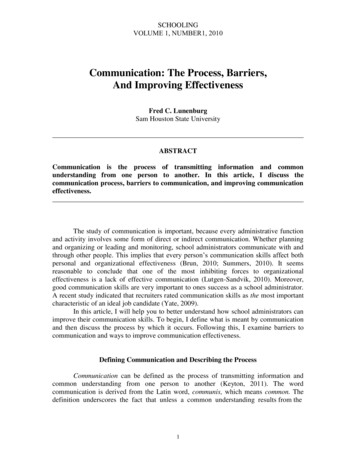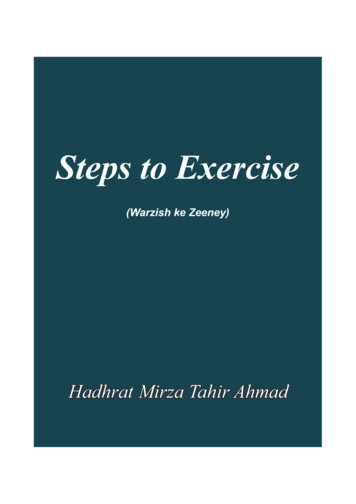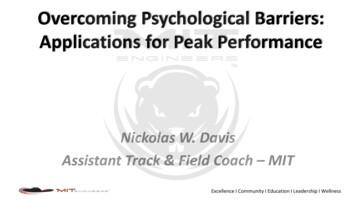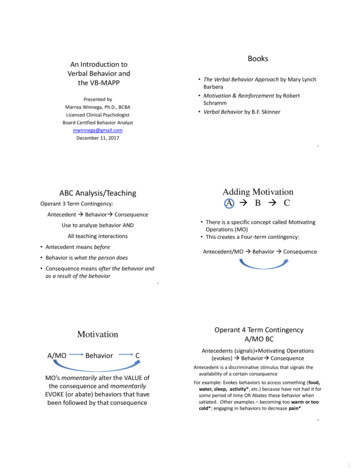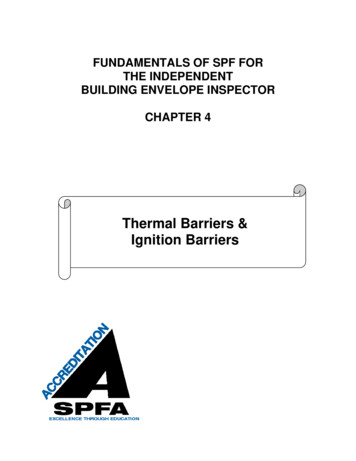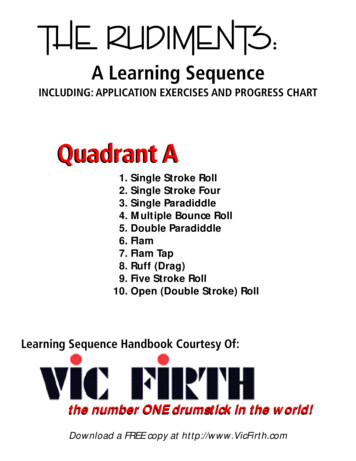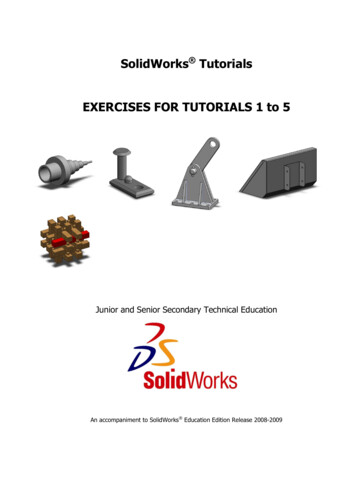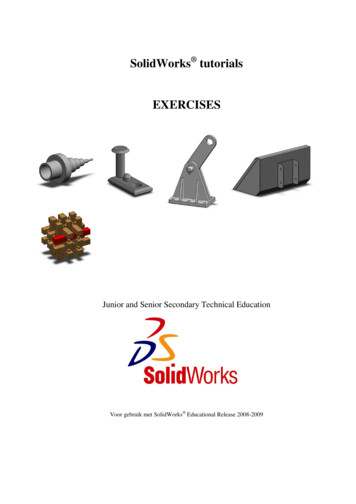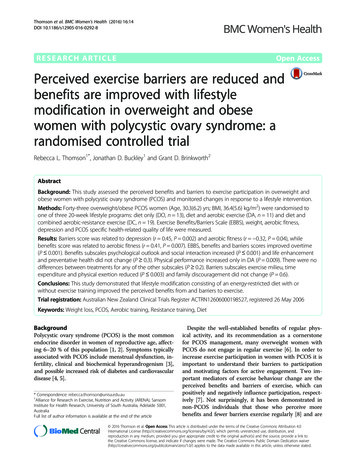
Transcription
Thomson et al. BMC Women's Health (2016) 16:14DOI 10.1186/s12905-016-0292-8RESEARCH ARTICLEOpen AccessPerceived exercise barriers are reduced andbenefits are improved with lifestylemodification in overweight and obesewomen with polycystic ovary syndrome: arandomised controlled trialRebecca L. Thomson1*, Jonathan D. Buckley1 and Grant D. Brinkworth2AbstractBackground: This study assessed the perceived benefits and barriers to exercise participation in overweight andobese women with polycystic ovary syndrome (PCOS) and monitored changes in response to a lifestyle intervention.Methods: Forty-three overweight/obese PCOS women (Age, 30.3(6.2) yrs; BMI, 36.4(5.6) kg/m2) were randomised toone of three 20-week lifestyle programs: diet only (DO, n 13), diet and aerobic exercise (DA, n 11) and diet andcombined aerobic-resistance exercise (DC, n 19). Exercise Benefits/Barriers Scale (EBBS), weight, aerobic fitness,depression and PCOS specific health-related quality of life were measured.Results: Barriers score was related to depression (r 0.45, P 0.002) and aerobic fitness (r 0.32, P 0.04), whilebenefits score was related to aerobic fitness (r 0.41, P 0.007). EBBS, benefits and barriers scores improved overtime(P 0.001). Benefits subscales psychological outlook and social interaction increased (P 0.001) and life enhancementand preventative health did not change (P 0.3). Physical performance increased only in DA (P 0.009). There were nodifferences between treatments for any of the other subscales (P 0.2). Barriers subscales exercise milieu, timeexpenditure and physical exertion reduced (P 0.003) and family discouragement did not change (P 0.6).Conclusions: This study demonstrated that lifestyle modification consisting of an energy-restricted diet with orwithout exercise training improved the perceived benefits from and barriers to exercise.Trial registration: Australian New Zealand Clinical Trials Register ACTRN12606000198527, registered 26 May 2006Keywords: Weight loss, PCOS, Aerobic training, Resistance training, DietBackgroundPolycystic ovary syndrome (PCOS) is the most commonendocrine disorder in women of reproductive age, affecting 6–20 % of this population [1, 2]. Symptoms typicallyassociated with PCOS include menstrual dysfunction, infertility, clinical and biochemical hyperandrogenism [3],and possible increased risk of diabetes and cardiovasculardisease [4, 5].* Correspondence: rebecca.thomson@unisa.edu.au1Alliance for Research in Exercise, Nutrition and Activity (ARENA), SansomInstitute for Health Research, University of South Australia, Adelaide 5001,AustraliaFull list of author information is available at the end of the articleDespite the well-established benefits of regular physical activity, and its recommendation as a cornerstonefor PCOS management, many overweight women withPCOS do not engage in regular exercise [6]. In order toincrease exercise participation in women with PCOS it isimportant to understand their barriers to participationand motivating factors for active engagement. Two important mediators of exercise behaviour change are theperceived benefits and barriers of exercise, which canpositively and negatively influence participation, respectively [7]. Not surprisingly, it has been demonstrated innon-PCOS individuals that those who perceive morebenefits and fewer barriers exercise regularly [8] and are 2016 Thomson et al. Open Access This article is distributed under the terms of the Creative Commons Attribution 4.0International License (http://creativecommons.org/licenses/by/4.0/), which permits unrestricted use, distribution, andreproduction in any medium, provided you give appropriate credit to the original author(s) and the source, provide a link tothe Creative Commons license, and indicate if changes were made. The Creative Commons Public Domain Dedication o/1.0/) applies to the data made available in this article, unless otherwise stated.
Thomson et al. BMC Women's Health (2016) 16:14Page 2 of 9more active compared with those who perceive fewerbenefits and more barriers [9, 10].To date limited research has examined the perceivedbenefits and barriers to exercise participation in overweight women with PCOS. One study in women withPCOS identified the most frequently reported barrierswere fatigue and the lack of time and motivators were tocontrol weight and improve health [11]. However, nostudies have investigated changes in the perceived benefitsand barriers following participation in a clinical-based lifestyle management and exercise intervention in womenwith PCOS. The aim of this study was to assess the perceived benefits and barriers to exercise participation inoverweight and obese women with PCOS and to monitorchanges in response to a lifestyle intervention.exercise (DC, diet and walking/jogging 3 times andstrength training 2 times per week). Participants in theDO group were asked to maintain their habitual sedentary physical activity levels and those in DA and DCattended at least one weekly supervised aerobic exercisesession per week. Participants and research staff werenot blinded to treatment allocation. Participants attendedthe CSIRO Clinical Research Unit in Adelaide, Australia atWeek 0, 10 and 20 and completed a validated ExerciseBenefits/Barriers Scale (EBBS) to determine perceptionsconcerning the benefits of and barriers to participating inexercise. Participants also had their height (baseline only),body weight and aerobic fitness measured and completedquestionnaires to assess depression and health-relatedquality of life.MethodsAssessmentsStudy designThe EBBS was used to assess perceived benefits and barriers to exercise [15]. The scale consisted of 43 itemswith a four point, forced choice Likert scale, to obtainthe strength of agreement (4 strongly agree, 3 agree,2 disagree and 1 strongly disagree) with statementsrelated to ideas about exercise. Total scores ranged from43 to 172 and the benefits score ranged from 29 to 116,with higher scores reflecting more perceived benefitsfrom exercise. Barriers scores ranged from 14 to 56 witha higher score indicating greater perceived barriers toexercise. The reported internal consistency (Cronbach’salpha) for the total, benefits and barriers scales were0.952, 0.953 and 0.866, respectively and test-retest reliability was 0.889, 0.893 and 0.772, respectively [15]. Subscalemean scores were also calculated (Perceived benefits:life enhancement, physical performance, psychologicaloutlook, social interaction and preventative health; Perceived barriers: exercise milieu, time expenditure, physicalexertion and family discouragement).Height and body weight were measured using a stadiometer (SECA, Hamburg, Germany) and electronic digitalscales (Mercury, AMZ 14, Tokyo, Japan), respectively.Body mass index (BMI) was calculated as weight (kg)divided by height (m)2. Aerobic fitness was measuredusing a graded exercise test on a motorised treadmill(Trackmaster TMX425CP, Full Vision Inc., Newton, KS)to symptom-limited exhaustion. The cardiorespiratoryresponse to exercise was assessed by indirect calorimetry(TrueOne 2400, Parvomedics, Sandy UT) and peak oxygen consumption (VO2peak) was taken to be the highestachieved during a 30-s measurement period.Depression was assessed using the Centre for Epidemiologic Studies Depression Scale (CES-D), which is a selfreported scale that measures the presence and severityof depressive symptoms occurring in the past week [16].Health-related quality of life was assessed using a validatedself-administered PCOS questionnaire (PCOSQ), whichThe data analysed for this study were obtained from asubset of 43 women who completed assessments forexercise benefits and barriers before and after participating in a randomised controlled trial that evaluatedthe effects of a hypocaloric diet with and without exercise training on metabolic and reproductive outcomes[12]. Details of the study and intervention have beenreported elsewhere [12, 13].In brief, sedentary overweight and obese women withPCOS were recruited by public advertisement and fromgeneral practitioner and specialists clinics from April 2006until the planned sample size was reached in February2007. PCOS was diagnosed according to the RotterdamCriteria [14], defined by the presence of 2 of the following3 criteria: polycystic ovaries on ultrasound; menstrual irregularity; and clinical or biochemical hyperandrogenism.Potential participants were excluded if they were participating in regular exercise ( 1 day/week of moderate intensity exercise), pregnant, breastfeeding, smoking, using oralcontraceptives or fertility treatments, undergoing medicaltreatment for depression, or had uncontrolled hypertension, diabetes, cancer or history of cardiovascular, respiratory, kidney or liver disease. Participants were excluded ifthey had any reproductive disorders unrelated to PCOS,non-classical adrenal hyperplasia or thyroid abnormalities.All participants provided written informed consent and allexperimental procedures were approved by the HumanEthics Committees of the University of South Australiaand the Commonwealth Scientific and Industrial ResearchOrganisation (CSIRO).Participants were randomly assigned by the trial manager using computer generation to one of three 20-weeklifestyle interventions: diet only (DO, 6000 kJ/day energy restricted high-protein meal plan), diet and aerobicexercise (DA, diet and walking/jogging 5 times per weekfor 25–45 min), or diet and combined aerobic-resistance
Thomson et al. BMC Women's Health (2016) 16:14included 5 domains: emotions, hair growth, body weight,infertility problems and menstrual problems [17]. The results of these scales have been previously reported [13],and these outcomes were used for correlational purposesin the present analysis.Data analysisStatistical analysis was performed using SPSS Statistics21 (IBM Corporation, Armonk, NY). Data were checkedfor normality prior to analysis and non-normally distributed data were transformed (EBBS subscales and PCOSQdomains by rank transformation, benefits score by takingthe inverse, and CES-D scores by taking the square root).The mean response for each statement was calculated andranked to determine the statements with the highestand lowest agreement. Baseline differences betweengroups were determined by one-way analysis of variance(ANOVA). The effect of the intervention on outcomeswas determined by repeated measures ANOVA with timeas the within-subject factor and treatment group as thebetween-subject factor. When there was a significanttime x treatment interaction effect, post-hoc analysiswas performed where appropriate to determine differencesbetween treatment means across time and Bonferroniadjustments were performed for multiple comparisons.Correlation analysis using Pearson’s correlation coefficientPage 3 of 9was used to determine associations between variables.Values are reported as mean (standard deviation, SD). Anα-level of significance was set at P 0.05.ResultsForty-three participants were included in this secondaryanalysis (Age, 30.3 (6.2) yrs; BMI, 36.4 (5.6) kg/m2; DO,n 13; DA, n 11, DC 19; Fig. 1). Baseline characteristics of participants included in this analysis are providedin Tables 1 and 2. There was no difference in any EBBSscores, demographics and PCOS features at baseline between those that completed and dropped out of theintervention (dropouts 42, DO 16, DA 13, DC 13;P 0.1). The barriers score, and physical exertion andtime expenditure subscale scores were significantly different between treatments at baseline (P 0.016, P 0.045and P 0.038 respectively, main effect from ANOVA),however only barriers and time expenditure were significantly higher in DO compared with DC following posthoc analysis (P 0.04).At baseline, statements with the highest scores (i.e.,perceived as most beneficial) were related to perceivedbenefits in the physical performance subscale and thebenefit statements with the lowest mean scores were inthe social interaction subscale (Table 3). Overall statementswith the lowest mean scores were related to perceivedFig. 1 Flow chart of participants in the study. DO, diet only; DA, diet and aerobic exercise; DC, diet and combined aerobic-resistance exercise
Thomson et al. BMC Women's Health (2016) 16:14Page 4 of 9Table 1 Outcomes at baseline and after 20 weeks of lifestyle modification for participants who completed the studyΔ Week 20Week 0DODADCDODADCTimeTime x TreatmentWeight (kg)107.2 (25.2)103.0 (21.9)96.1 (19.4) 9.2 (6.0) 12.5 (6.4) 8.6 (5.8)P 0.001P 0.2VO2peak (ml/kg/min)23.8 (3.7)25.5 (3.7)24.4 (2.8) 0.5 (2.9)4.4 (4.4)*2.6 (2.7)*P 0.001P 0.01CES-D19 (10)17 (8)13 (8) 0.9 (9.0) 5.0 (10.3)0.4 (8.3)P 0.001P 0.74.0 (1.4)4.4 (0.8)4.9 (0.9)0.5 (0.8)0.7 (1.0)0.4 (1.0)P 0.001P 0.5Body Hair2.9 (1.5)3.1 (1.2)3.4 (1.1)0.3 (1.0)0.5 (0.6)0.1 (0.7)P 0.05P 0.5PCOSQ: EmotionWeight1.9 (0.8)2.1 (0.9)2.2 (0.9)0.9 (0.8)1.4 (0.8)1.3 (1.0)P 0.001P 0.1Infertility problems4.3 (1.9)4.7 (1.4)4.6 (1.4)0.4 (0.8)0.9 (1.1)0.7 (1.0)P 0.001P 0.5Menstrual problems3.4 (1.3)3.8 (1.1)3.7 (1.1)0.3 (2.2)0.5 (1.3)0.8 (1.2)P 0.03P 0.7CES-D centre for epidemiologic studies depression scale, DA diet and aerobic exercise, DC diet and combined aerobic and resistance exercise, DO diet only,PCOSQ polycystic ovary syndrome questionnaire, VO2peak peak oxygen consumption, Δ changeValues are mean (SD); *significantly different to DO (P 0.05)barriers, with the two lowest from the family discouragement subscale and third from the exercise milieu subscale(Table 3). The perceived barriers with the highest scores(i.e., perceived as greatest barriers) were in the physicalexertion subscale (Table 3). The mean benefits scorewas significantly higher than the mean barriers score(3.11 (0.32) v 2.14 (0.32), respectively; P 0.001).The intervention achieved significant weight loss andimprovements in aerobic fitness, depressive symptomsand health-related quality of life (Table 1). VO2peak improved in DA and DC only (Week 0–20, P 0.006).There was no difference between treatments for theother outcomes (P 0.1). Overall the EBBS, benefits andbarriers scores improved (P 0.001; Table 2) and therewere no significant differences between the treatmentgroups (P 0.2 and P 0.1 controlling for baseline differences). EBBS and barriers scores significantly improvedat Week 10, with no further improvement at Week 20(P 0.001 for Week 0–10 and 0–20, P 1.0 for Week10–20). Benefits scores had not changed at Week 10(P 0.9), but significantly increased at Week 20 (P 0.004;P 0.003 for Week 10–20). Overall, the benefits subscalespsychological outlook and social interaction increased(P 0.001) and physical performance, life enhancementand preventative health did not change (P 0.1). For thebarriers subscale exercise milieu, time expenditure andphysical exertion significantly reduced (P 0.003) andfamily discouragement did not change (P 0.6). There wasa differential response between treatments for physicalperformance (time x treatment P 0.04) such that onlyDA experienced a significant increase (P 0.009). Therewere no differences between treatments for any of theother subscales (P 0.2). Assessment of individual statements showed the greatest increase was with the statement‘I enjoy exercise’ in both DA and DC (0.64 (0.67) and 0.53(0.51), respectively). For DO the greatest increase was forthe statement ‘Exercise gives me a sense of personal accomplishment’ (0.39 ( 0.77)).Significant correlations between EBBS scores and subscales and other outcomes at baseline and changes after20 weeks of lifestyle modification are shown in Table 4.After controlling for weight loss, changes in barriers scorecorrelated with depression scores (r 0.48, P 0.001), andPCOSQ emotion (r 0.56, P 0.001) and weight domains(r 0.39, P 0.01).DiscussionThis study showed that lifestyle modification consistingof an energy-restricted diet with or without exercisetraining improved the perceived benefits from and barriers to exercise. The only difference observed betweentreatments was for the physical performance subscale,which only increased significantly in DA. This groupperformed more aerobic exercise and had a greater increase in cardio-respiratory fitness, which could explainwhy they perceived a significant improvement in physicalperformance. While DC also performed aerobic exercise,two sessions per week were replaced with resistancetraining. This suggests that cardio-respiratory fitness isperceived to be more related to improved physical performance, not increased strength. It was somewhat unexpected that the majority of the perceived benefits andbarriers improved in all treatment groups given thatDO did not undertake exercise training. This indicatesthe possibility that weight loss induced by dietary restriction may promote positive perceptions, particularlyfor increased life enhancement and reduced physicalexertion. This is further evidenced by the associationsbetween weight loss and improvement in life enhancement(strongest perceived benefit) and reduction in barriers. Thepossibility these effects occurred in response to participating in a professionally supervised weight loss program cannot be ruled out [18] and absence of a non-dieting orexercising control group also limits the ability to determinethe specific effects of dieting and exercise. DO were askedto maintain their sedentary lifestyle; however this was not
Week 0Week 10Week 20DODADCDODADCDODADCTimeTime x TreatmentEBBS Score128 (14)129 (11)131 (11)132 (14)140 (13)136 (14)132 (14)141 (12)136 (14)P 0.001P 0.2Benefits Score91 (12)89 (9)89 (7)86 (9)91 (8)89 (11)93 (12)97 (11)92 (9)P 0.001P 0.3Barriers Score33 (4)*30 (4)28 (4)31 (4)25 (5)26 (5)30 (4)25 (5)26 (7)P 0.001P 0.33.15 (0.44)3.15 (0.41)3.07 (0.33)3.25 (0.38)3.34 (0.45)3.09 (0.38)3.28 (0.44)3.37 (0.44)3.11 (0.39)P 0.1P 0.2Thomson et al. BMC Women's Health (2016) 16:14Table 2 Exercise Benefits/Barriers Scale scores at Week 0, 10 and 20 during three lifestyle modification programsPerceived Benefits SubscalesLife enhancementPhysical performance3.41 (0.44)3.26 (0.38)3.33 (0.34)3.34 (0.41)3.46 (0.41)3.39 (0.37)3.38 (0.41)3.54 (0.37)**3.36 (0.37)P 0.1P 0.04Psychological outlook3.13 (0.48)3.08 (0.23)3.12 (0.32)3.20 (0.46)3.33 (0.28)3.44 (0.33)3.30 (0.45)3.36 (0.38)3.33 (0.38)P 0.001P 0.2Social interaction2.44 (0.50)2.36 (0.52)2.61 (0.47)2.65 (0.55)2.75 (0.76)2.71 (0.59)2.60 (0.39)2.68 (0.62)2.76 (0.63)P 0.001P 0.4Preventative health3.33 (0.59)3.30 (0.38)3.23 (0.35)3.36 (0.48)3.36 (0.41)3.23 (0.37)3.35 (0.45)3.55 (0.48)3.23 (0.40)P 0.6P 0.62.16 (0.53)2.08 (0.44)1.90 (0.32)2.06 (0.39)1.73 (0.54)1.67 (0.43)1.95 (0.36)1.69 (0.43)1.69 (0.48)P 0.001P 0.5Perceived Barriers SubscalesExercise milieuTime expenditure2.36 (0.46)*2.09 (0.50)1.98 (0.39)2.18 (0.52)1.64 (0.38)1.87 (0.49)2.08 (0.34)1.79 (0.58)1.91 (0.72)P 0.003P 0.3Physical exertion3.03 (0.63)2.85 (0.37)2.51 (0.49)2.78 (0.50)2.52 (0.53)2.42 (0.44)2.90 (0.63)2.42 (0.45)2.32 (0.53)P 0.001P 0.2Family discouragement1.69 (0.56)1.41 (0.49)1.61 (0.61)1.85 (0.38)1.32 (0.46)1.61 (0.70)1.62 (0.42)1.36 (0.50)1.58 (0.69)P 0.6P 0.6DA diet and aerobic exercise, DC diet and combined aerobic and resistance exercise, DO diet only, EBBS exercise benefits/barriers scaleValues are mean (SD); *significantly different compared with DC, P 0.04; **significantly different compared with Week 0, P 0.009Page 5 of 9
Thomson et al. BMC Women's Health (2016) 16:14Page 6 of 9Table 3 Highest and lowest ranked perceived benefits andbarriers statements at baselineBenefits Statements - Highest AgreementMean ScoreExercise improves the functioning of mycardiovascular system3.44 (0.50)Exercise improves the way my body looks3.40 (0.54)Exercise increases my level of physical fitness3.37 (0.54)Benefits Statements - Lowest AgreementExercise increases my acceptance by others2.35 (0.65)Exercise lets me have contact with friendsand persons I enjoy2.51 (0.74)Exercise is good entertainment for me2.51 (0.55)Barriers Statements - Highest AgreementExercise tires me2.86 (0.71)Exercise is hard work for me2.79 (0.67)I am fatigued by exercise2.60 (0.62)Barriers Statements - Lowest AgreementMy family members do not encourageme to exercise1.56 (0.59)My spouse (or significant other) does notencourage exercising1.63 (0.70)I think people in exercise clothes look funny1.72 (0.59)Values are mean (SD). 4 strongly agree, 3 agree, 2 disagree,1 strongly disagreeobjectively measured and it is possible they did begin to engage in exercise as they lost weight and began to feel morepositive about themselves.The majority of the improvement in the EBBS andbarriers scores occurred in the first 10 weeks of theintervention. Commencement of a new exercise programcan be perceived as more fatiguing, which could accountfor physical exertion being ranked the greatest perceivedbarrier at baseline. Physical exertion scores decreasedduring the intervention, suggesting perceived physicalexertion reduced as participants adapted to the intervention. There were significant improvements in benefitscores overall, but unlike the effect on barrier scores, improvements occurred primarily during the final 10 weeksof the intervention. The exact reason for this differentialresponse is unclear. It is possible the lag time in the observation of the improvements in the benefits scores could bedue to the need for an individual to become accustomedto lifestyle changes and for there to be sufficient time forbenefits to become apparent. Thus, these findings suggestthat during the initial phase of a lifestyle interventionthere is a reduction in the barriers to exercise which issubsequently followed by an increase in the perception ofbenefits of exercise. Therefore it may be more beneficialto focus on addressing the barriers to exercise at the beginning of a lifestyle intervention, with a change in focusto the benefits and enjoyment during the latter half of theprogram to promote continued adherence.Table 4 Correlations between EBBS scores and measures of fitness, depression, emotion, age, and obesity at (a) baseline and (b)after 20 weeks of lifestyle interventiona) Week 0EBBSCES-DVO2peakr 0.31***r 0.45*Benefitsr 0.41*Physical performancer 0.33***Social interactionr 0.35**Barriersr 0.45*Exercise milieur 0.40*CES-DEBBSr 0.46*Benefitsr 0.32***r 0.32***r 0.36**r 0.32***r 0.36**Weightr 0.41*PCOSQ EmotionPCOSQ Infertility ProblemsPCOSQ Weightr 0.31***r 0.41*PCOSQ MenstrualProblemsr 0.33***r 0.49*r 0.34**r 0.57*r 0.52*Exercise milieuPhysical exertionAger 0.49*Life enhancementTime expenditureBMIr 0.46*Family discouragementBarriersPCOSQ Infertility Problemsr 0.50*Psychological outlookb) Changes Week 20-Week 0PCOSQ Emotionr 0.60*r 0.40*r 0.34***r 0.63*r 0.50*BMI body mass index, CES-D centre for epidemiologic studies depression scale, EBBS exercise benefits/barriers scale, PCOSQ polycystic ovary syndromequestionnaire, VO2peak peak oxygen consumption*P 0.008; **P 0.02, ***P 0.05
Thomson et al. BMC Women's Health (2016) 16:14It has been suggested that barriers are the single mostpowerful predictor of health behaviour [19]. The mostcommon perceived barriers reported in this study wererelated to physical exertion (exercise is tiring, hard workand fatiguing). These statements have been commonlyreported in other populations as one of the main barriers [8, 10, 20–22]. Specifically in women with PCOS,previously identified barriers were lack of time, fatigueand lack of confidence about maintaining physical activity and compared with women without PCOS, womenwith PCOS were more likely to report this lack of confidence about maintaining physical activity, fear of injuryand physical limitations as barriers [11]. Collectively,these barriers suggest it is important to gradually increaseintensity, duration and frequency of exercise to reduce thephysical exertion barrier and injury risk. It may also be important to educate women with PCOS about the benefitsof adequate rest, hydration and nutrition to promote recovery between exercise sessions and reduce the risk ofchronic fatigue. At baseline, barriers scores were related tolevels of depressive symptoms and emotional difficultiesassociated with PCOS, and not body weight. While causation of these factors could not be determined, it may beimportant to address depressive symptoms and emotionaldifficulties before starting an exercise program to reducepotential barriers to participating in exercise and increasethe likelihood of success and exercise adherence. The participants were also aware of the study treatment they hadbeen randomised to at the time of completing the questionnaires at baseline which could explain why the DOgroup reported higher perceived barriers.Barriers relating to family discouragement and exercisemilieu were not highly scored. This has also been reportedpreviously in young female university students [20]. In thepresent study family discouragement was associated withage, with younger participants less likely to perceive it as abarrier. Thus, the impact of family discouragement maybe dependent on the different circumstances of older andyounger women who may be in different life stages withdiffering family commitments (studying or working fulltime, married, children, etc.). Social factors, includingsupport from family members or significant others caninfluence health by either promoting or underminingbehaviour change [23]. Women with PCOS have reported more sources of support than women withoutPCOS [11]. It is promising to see the women in thiscurrent study had low agreement with the perceivedbarriers. It is possible that this study is not representativeof the general PCOS population since they had voluntarilyenrolled in a lifestyle intervention program which mayhave included exercise.In agreement with other studies [8, 20, 21], the greatest and lowest perceived benefits were related to physicalperformance and social interaction, respectively. In aPage 7 of 9recent study, women with PCOS reported their motivators for physical activity were to control weight, improvehealth and increase energy [11]. Preventative health wasalso seen as an important benefit, which is not always reported in younger populations who are more concernedwith physical performance and appearance [8]. Preventative health is more likely reported in middle-aged andolder adults who see chronic disease management as animportant reason to exercise. It is possible that becausewomen with PCOS have greater awareness of the negativeconsequences of the syndrome (obesity, insulin resistance,increased risk of cardiovascular disease and type 2 diabetes), they are more likely to perceive the potential healthbenefits of engaging in exercise or other lifestyle interventions. However, recently a study reported that only 40 % ofwomen with PCOS were motivated to exercise to controla medical condition [11]. This suggests that the importance of physical activity for managing PCOS symptomsand minimising long-term complications of PCOS maynot be fully understood [11]. The greatest perceived benefits of physical performance could be used to promotephysical activity to women. It is also possible that some ofthe lower scored statements such as life enhancementand psychological outlook also require further promotionto this population to increase awareness of these otherexercise benefits that may be less well recognised andunderstood.Overall, both the perceived benefits and barriers scalesimproved during the study; but not all subscales changed.This could have been due to the relatively high or low baseline levels limiting the possibility of further change. Thestatements that experienced the greatest improvementswere associated with the psychological outlook subscale.Furthermore the greater perceived exercise enjoyment inthe participants in the exercising groups has important implications since exercise enjoyment is considered essentialto exercise adherence [24]. Intrinsic motivation, which includes some of the perceived benefits assessed in psychological outlook scale, is important for sustaining behaviours[25]. The changes in perceived benefits and barriers werealso related to improvements in psychological wellbeing(symptoms of depression and PCOS specific health-relatedquality of life), again highlighting the importance of alsoaddressing psychological wellbeing in women with PCOSduring lifestyle modification. The EBBS scale was designedfor the general population and has not been validated inPCOS. Symptoms and co-morbidities associated withPCOS may present different barriers to exercise that werenot identified with EBBS. Further research is needed toinvestigate PCOS specific issues. It is also important toacknowledge that only some benefits and barriers towardsexercise were investigated. It is possible that participantsperceived other benefits and barriers that were notassessed. Specifically, those that dropped out of the study
Thomson et al. BMC Women's Health (2016) 16:14may have perceived greater barriers to other aspects of thestudy that were not assessed. This study was also limitedby its sample size and larger studies are needed to furtherinvestigate the impact of lifestyle modification on perceived benefits and barriers to exercise and other lifestyleinterventions.ConclusionsTo our knowledge this is the first study to evaluate theeffect of lifestyle interventions on perceived benefits fromand barriers to exercise in overweight and obese womenwith PCOS. Many women with PCOS are sedentary andrepresent an important at-risk population that could benefitfrom health promotion efforts that target physical activitybehaviour. Exercise is important for PCOS managementand these study findings advan
one of three 20-week lifestyle programs: diet only (DO, n 13), diet and aerobic exercise (DA, n 11)anddietand combined aerobic-resistance exercise (DC, n 19). Exercise Benefits/Barriers Scale (EBBS), weight, aerobic fitness, depression and PCOS
